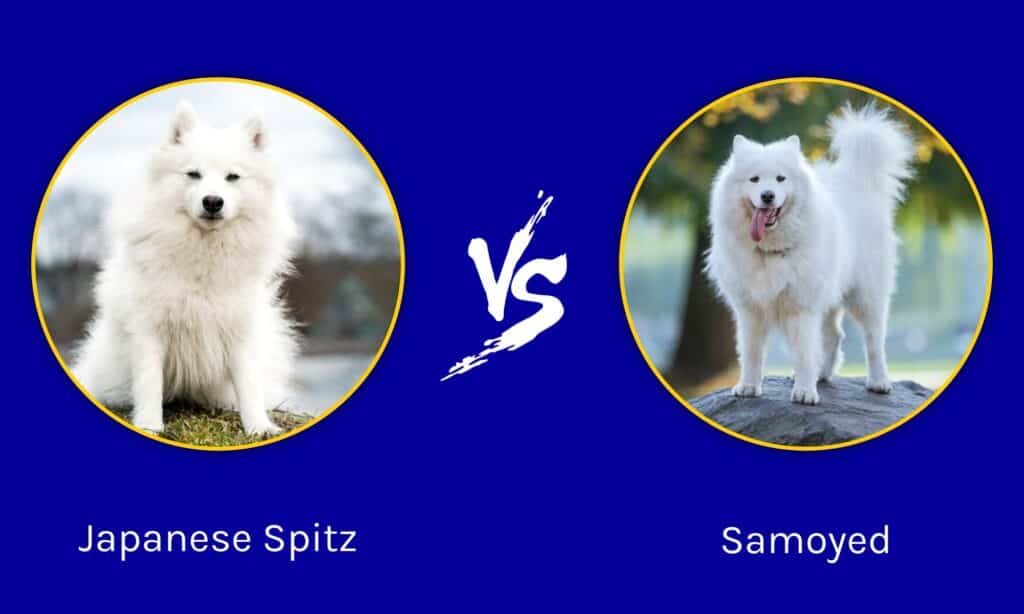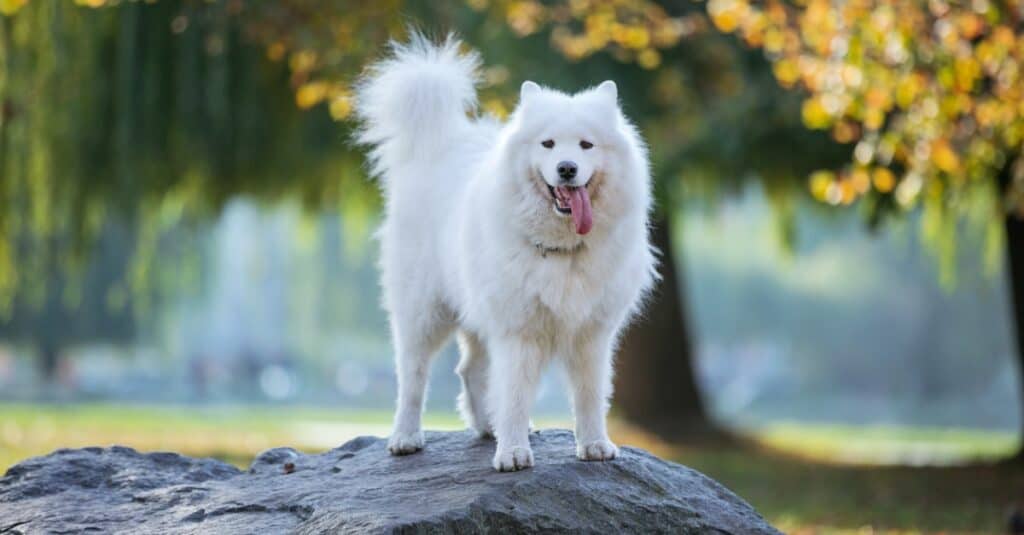Fluffy white dogs have a lot in common, but there are some notable differences between the Japanese Spitz and Samoyed. Their appearances hardly differ, with the most noticeable distinction being their size.
In this article, we’ll talk all about these breeds, how they differ, and which one might be best for you!
Comparing Japanese Spitz vs Samoyed

| Japanese Spitz | Samoyed | |
|---|---|---|
| Size | 12-15 inches, 10-25 pounds | 19-23.5 inches, 35-65 pounds |
| Appearance | White, medium-length double coat | Long double coat in the colors biscuit, cream, white, or white and biscuit |
| Lifespan | 10-16 years | 12-14 years |
| Temperament | Affectionate, dog-friendly, somewhat alert | Extremely affectionate, might be stand-offish with other dogs, very alert |
| Energy Level | Moderate | Very high |
| Trainability | Very easy | Easy |
| Barking Level | Moderate | High |
Key Differences Between Japanese Spitz and Samoyed
The key differences between the Japanese Spitz and Samoyed are appearance, lifespan, temperament, trainability, energy level, and barking level.
Let’s look into these in greater detail!
Japanese Spitz vs Samoyed: Size

Japanese Spitzes weigh just 25 pounds.
©K-Smile love/Shutterstock.com
Even the largest Japanese Spitz stands at just 15 inches and weighs 25 pounds—and the smallest can weigh just 10 pounds! Samoyeds, on the other hand, are quite a bit larger at 19-23.5 inches and 35-65 pounds.
For owners of these dogs, size can make a difference when it comes to expenses, grooming, and handling. Food bills increase depending on the size of your dog, and it may be more difficult to hang onto a leash if they pull, and lifting them is harder. While both of these breeds are fluffy and require similar grooming, Samoyeds will take longer to brush.
However, their larger size also comes with benefits like deterring strangers. While both breeds tend to think everyone’s a friend, Samoyeds are alert and sometimes make good watchdogs. Just don’t trust them to guard the house ferociously!
Japanese Spitz vs Samoyed: Appearance
At first glance, both breeds have light, fluffy coats, bright eyes, upright ears, and curled tails. They’re incredibly similar! However, their fur sets them apart. While the Japanese Spitz has medium-length white fur, Samoyeds have longer hair that can be white, biscuit, cream, or white and biscuit.
This small difference, along with their size, is what differentiates them in the looks department. However, it can still be difficult to tell a white Samoyed and a Japanese Spitz apart!
Japanese Spitz vs Samoyed: Lifespan
Both breeds can live up to 14 years and are more likely to reach this age if fed a high-quality diet, given proper exercise, and taken to the veterinarian regularly.
However, Japanese Spitzes are sometimes shorter-lived, with the lower end of their average lifespan being 10 years compared to the Samoyed’s 12 years.
Japanese Spitz vs Samoyed: Temperament

Samoyeds might appear to be downright clingy.
©iStock.com/photobac
While these dogs have similar temperaments, some slight inconsistencies differentiate them. These include alertness, affection toward family, and the ability to get along with other dogs.
Japanese Spitzes are affectionate like any other dog and truly love their families! However, Samoyeds take it to another level and might be downright clingy. This is because they were bred as companion animals, living in close quarters and even sleeping curled up with their people.
Samoyeds also tend to be more alert. While they don’t make good guard dogs due to their friendliness, they can make decent watchdogs—sometimes even barking to notify you of things you’d rather they not, like the mailman approaching the house.
Lastly, some Samoyeds may be dog-selective or standoffish toward new dogs. Japanese Spitzes treat them just like they do people—they think they’re all friends!
This is a fantastic trait but may come with its challenges, such as being too outgoing toward more reserved pups.
Japanese Spitz vs Samoyed: Energy Level
These dogs have similar energy levels, but Samoyeds are slightly more energetic and may take more investment to exercise due to their larger size.
Both dogs benefit from at least one daily walk and playtime either in the house or outdoors. However, the Japanese Spitz benefits from its size and can get a lot of energy out while running around the living room!
Japanese Spitz vs Samoyed: Trainability
While Japanese Spitzes are incredibly people-pleasing, Samoyeds have a slight independent streak. It’s important to show consistency and set boundaries for these pups.
However, Samoyeds still aren’t difficult to train by any means. You likely won’t have a problem as long as you treat them well and use positive training methods.
Japanese Spitz vs Samoyed: Barking Level

The Japanese Spitz is a moderate barker.
©joonasp/Shutterstock.com
Samoyeds are incredibly vocal, while Japanese Spitzes are moderate barkers. While both can develop problem barking behaviors, it’s most common in Samoyeds.
Counteract this rebellion by ensuring all of your dog’s needs are met. They must be exercised adequately every day, or they might turn to over-vocalizing or destructive behaviors.
Samoyeds are also prone to clinginess and separation anxiety. Teach them how to be alone when they’re young by giving them good experiences, and remember that these dogs aren’t suited to long stretches of time alone in the house. They do best with a family where someone is home most of the day.
The photo featured at the top of this post is © joonasp/Shutterstock.com
Ready to discover the top 10 cutest dog breeds in the entire world?
How about the fastest dogs, the largest dogs and those that are -- quite frankly -- just the kindest dogs on the planet? Each day, AZ Animals sends out lists just like this to our thousands of email subscribers. And the best part? It's FREE. Join today by entering your email below.
Thank you for reading! Have some feedback for us? Contact the AZ Animals editorial team.






